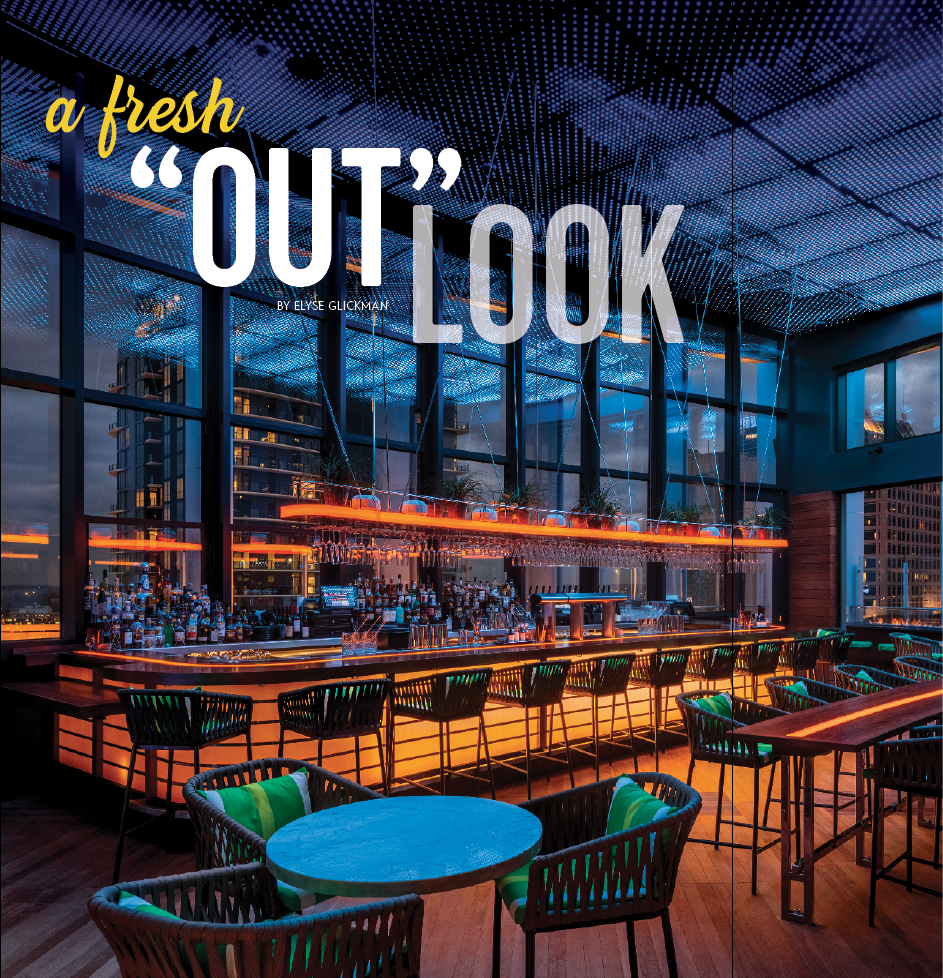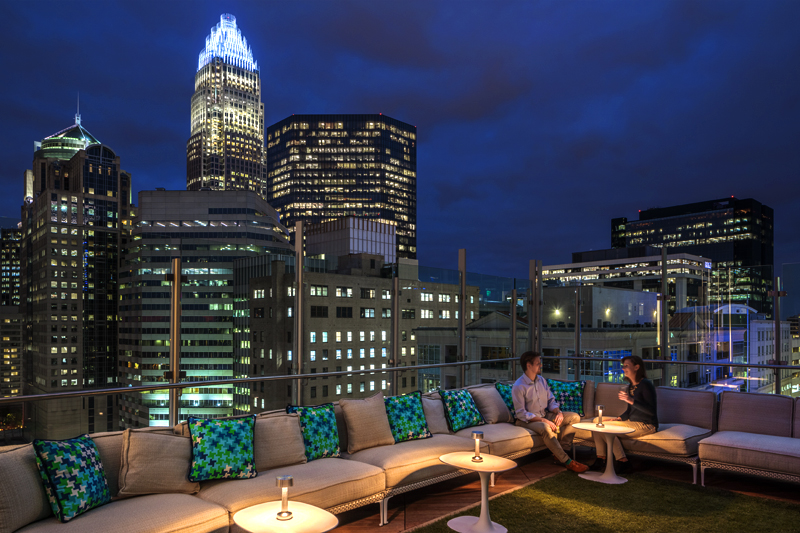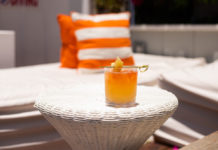
THE OUTDOORS IS “IN”.
By Elyse Glickman
………………………………………
when we think about “al fresco” dining and imbibing, chances are continental Europe comes to mind—from the sidewalk cafes of Paris to the patios of Italy and Spain to the summer beer gardens of Germany and Austria. There’s plenty of that joie-de-vivre in our warmer states year-round. That spirit is now being translated across the country by venue owners who are no longer content with putting tables and chairs out only when the mercury passes 65 degrees.
“The biggest trend in outdoor space is having outdoor space,” says Susan Pitaccio, President of Maxey Hayse Design Studios in Montclair, New Jersey. “People work inside all day, so the thinking goes that if they can be outside, it will make life that much happier and venues catering to them more profitable.”
There’s a new paradigm in developing outdoor space for longer “seasons” or even year-round use far beyond Florida and Southern California. Beyond investing in patio heaters and umbrellas, developing an outdoor space requires owners to put in more thought—from preparing questions for prospective designers to being sure the right materials are factored into the equation. Screens and retractable ceilings are also getting serious consideration.
“When designing an outdoor bar, you don’t want to specify furniture and materials that are not suitable for commercial/outdoor use,” advises Michelle Hanna, Interior Designer at
The Johnson Studio, a force behind the Kimpton Tryon Park Hotel’s Merchant and Trade rooftop in Charlotte, North Carolina; South City Kitchen in Alpharetta, Georgia; and the KR Steak Bar in Atlanta’s Peachtree Hills.
“Umbrellas, for example, should be made from high-quality awning fabric that is durable and easy to clean,” continues Hanna. “It is a good idea to consider perforations in the design of tabletops and furniture to allow for water drainage and that can limit the effects of wind. Don’t over-light your patio but instead keep it ambient with candle, lantern, or twinkle lights. And don’t limit yourself to loose tables and chairs. Incorporate a variety of seating types and outdoor upholstery, even outdoor vinyl.”
Pitaccio says planning in the beginning will save bars in the long run. “Focusing on the function and necessity of the outdoor space is important because, in the long term, this is what will help owners maintain it,” says Pitaccio. “Consider how large your space is, how many people are you trying to seat, can you keep the furniture fixed and outdoors full time or will mobile pieces work better, and do you have a space to store them? Though outdoor furniture can handle the weather, do you really want it getting snowed on or the seat cushions getting wet even with their indoor/outdoor fabric?”
Pitaccio also says to make sure inside and outside aesthetics blend together seamlessly. The patio should reflect the bar’s “brand” as much as the interiors do.
Pitaccio and Hanna also strongly recommend owners do their homework on city, state, or county building codes before sealing their plans in place and bringing in builders. Pitaccio says that her commission for the Mad Hatter in Sea Bright, New Jersey, originally destroyed by Hurricane Sandy, required five years of government approvals before the rebuild could begin.
“Some jurisdictions require a barrier between guest and pedestrian,” says Hanna. “It is also important to understand the climate, as it can affect material selection for the space. You might not want to specify metal that is not powder coated as it will rust, especially in a coastal area.
If you are using wood, select a species that is conducive to the elements such as Teak, Ipe, or Red Grandis.”
Dieter Cartwright from New York-based Warren Red, the firm behind The Outsider at Milwaukee’s Kimpton Journeyman Hotel, observes that his company has seen an uptick in demand for custom wood furniture for rooftop bars and restaurants and custom decorative light fixtures replacing the “Tivoli” string lights for a more permanent effect that feels specific to the client’s restaurant and location.

“In many cases, [it is not just about] practicality, but about a venue’s identity and culture,” says Cartwright. “A rooftop or outdoor bar in Milwaukee will feel very different to one in Miami, stylistically, from a brand identity point of view. Understanding that is critical and the magic of good design.”
With that, he reminds clients that every city and region’s weather conditions will alter the equation for materials and design choices totaling up to the perfect bespoke outdoor experience.
“Dodging rain in isn’t a big issue in LA, but in Miami, time by the pool sipping a cocktail may be interrupted for a few minutes by a downpour. Customers there will want to be back out in the sun as soon as the rain goes away,” says Cartwright.
“In colder climates, it gets a little trickier. Freeze-thaw has to be considered in the selection of materials and finishes. This also applies to outdoor plumbing. At The Outsider, all exterior plumbing lines had to be installed with a specialized fitting for connecting an air compressor. At the end of the outdoor season, air is forced through the outdoor plumbing system to expel any water so freezing won’t burst pipes over the winter.”
Designers Jessica Gracey and Allison Weber of Gensler Chicago agree that major considerations in outdoor space planning must include opting for soft, natural lighting; adequate off-season furniture storage; and whenever possible, working with manufacturers to make sure furniture and fabric finishes are resistant to the heat, sun, and salt. Also, other small details (such as barstools having a footrest to extend the life of the chair) can’t be overlooked.
“Patrons need space to feel comfortable, and it seems that when outside you should plan a bit more generously to achieve that feeling of release,” says Weber. “It’s important to consider the entire experience of the space, views, flow, textures, comfort, temperature to name a few. The space is setting the environment for the food and drink, and it all needs to be thoughtful and connected.”
Weber and Gracey stress that less is more in outdoor décor—even with fire pits, walls, large planters, etc. coming into vogue. The trick is to create a substantial style through the arrangement of these elements while having a setup that’s easy for guests and staff to navigate.
“We are seeing heavy coordination to conceal elements to establish comfort, whether shelter from the elements or subtle lighting that prolongs the use of the space,” says Weber. “We are seeing living room settings brought to the outdoors, which are commercial quality yet have a residential aesthetic.”
“In seasonal climates, we are seeing an acceptance that the furniture will only see limited outdoor use, and a general preference for form over function,” says Gracey. “While durability is still a driver, an aesthetic fit is winning out over bulky, weather-resistant, high-gloss finishes. At Tied House, there is a strong connection to the outdoor space, so it was important to the client that the finishes and furniture selections all correlated.”
Andy Gould, Co-Owner of The Moonlighter (a new destination for craft beers and ciders owned by the Scofflaw Group in Chicago), reflected on his recent experience pulling together an outdoor space with the assistance of local design experts that tackled the Windy City’s unpredictable weather head-on.
“Chicagoans are stoked for patio season after months of winter hibernation, and we make the most of days that aren’t picture perfect by incorporating outdoor fireplaces, a covered porch, and garage doors that let our guests enjoy the outdoors while staying warm and dry,” says Gould. “As far as we’re concerned, comfort and function are always on trend. Fire pits and fireplaces have taken the place of infrared heaters while adding a relaxing camp vibe.”
Gould also suggests adding in clear waterproofing, like a deck stain, to keep your patio looking sharp; choosing aluminum furniture, which can easily be moved inside during the off-season; and remembering that drainage is critical.
While durability is still a driver, an aesthetic fit is winning out over bulky, weather-resistant, high-gloss finishes. At Tied House, there is a strong connection to the outdoor space, so it was important to the client that the finishes and furniture selections all correlated.
Cartwright and the other designers also agree that a bar owner can never pay too much attention to engineering the social dynamics of an outdoor space.
“To have a rooftop with a great view for a bar or restaurant setting is a gift, but that alone is not enough,” says Cartwright. “You need to be highly analytical and have mad design skills to create a special place for people to gather.”








